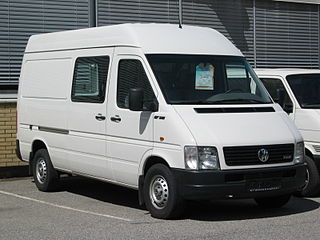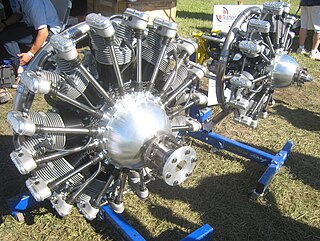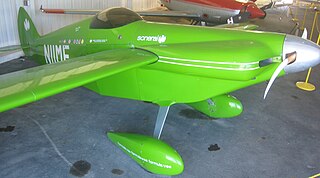
The Volkswagen Type 2, known officially as the Transporter, Kombi or Microbus, or, informally, as the Bus (US), Camper (UK) or Bulli (Germany), is a forward control light commercial vehicle introduced in 1950 by the German automaker Volkswagen as its second car model. Following – and initially deriving from – Volkswagen's first model, the Type 1 (Beetle), it was given the factory designation Type 2.

The Volkswagen Transporter LT is the largest light commercial panel van produced by Volkswagen from 1975 to 2006, before being replaced by the Crafter. Two generations were produced.
Sonex Aircraft, LLC is an American kit aircraft manufacturer located in Oshkosh, Wisconsin, producing kits for four all-metal homebuilt monoplanes. The company was founded in 1998 by John Monnett, who has designed the Monnett Sonerai sport aircraft series, Monnett Monerai sailplane, Monnett Moni motorglider, and Monnett Monex racer. Monnett designs are displayed in the Steven F. Udvar-Hazy Center of the National Air and Space Museum near Washington D.C.

Limbach Flugmotoren is a German company that produces aircraft engines.

Volkswagen Commercial Vehicles is a German marque of light commercial vehicles, owned by Volkswagen Group. It is headquartered in Hannover, Lower Saxony, Germany. Originally part of Volkswagen Passenger Cars, it has operated as a separate marque since 1995.

The Sonex, Waiex and Xenos are a family of lightweight, metal, low-wing, two seat homebuilt aircraft. Kits are produced and marketed by Sonex Aircraft, a small manufacturer based in Oshkosh, Wisconsin. By 2014, 500 customer built aircraft had been completed. The Sonex can also be built from plans.

The Volkswagen Type 14A is a convertible Volkswagen Type 1 produced by German coachbuilder Hebmüller and Sohn after the Second World War.

The Sonerai is a small, VW-powered homebuilt aircraft, designed by John Monnett. The Sonerai began to compete as a single-seat, mid-wing, tailwheel Formula-V racer class formed in 1972. The Sonerai soon evolved into a two-seat model called the Sonerai II.
The SDI engine is a design of naturally aspirated (NA) direct injection diesel engine developed and produced by Volkswagen Group for use in cars and vans, along with marine engine and Volkswagen Industrial Motor applications.

The EA827 family of petrol engines was initially developed by Audi under Ludwig Kraus leadership and introduced in 1972 by the B1-series Audi 80, and went on to power many Volkswagen Group models. This is a very robust water-cooled engine configuration for four- up to eight- cylinders. In Brazil this engine was produced under the name Volkswagen AP AP.

The Rotax 503 is a 37 kW (50 hp), inline 2-cylinder, two-stroke aircraft engine, built by BRP-Rotax GmbH & Co. KG of Austria for use in ultralight aircraft.
The Rotax 377 is a 35 hp (26 kW), twin-cylinder, two-stroke aircraft engine, that was built by BRP-Rotax GmbH & Co. KG of Austria for use in ultralight aircraft.

The Rotec R3600 is a nine-cylinder radial engine built by Rotec Aerosport Pty Ltd in Australia. Initially released in 2005, it was a followup of the 7-cylinder Rotec R2800 released five years earlier. Both this engine and its smaller cousin have been frequently used as both replacement engines for vintage World War 1 aircraft, and reproduction aircraft from the same vintage. Some notable aircraft this engine has been used in are the Fokker Triplane, Sopwith Camel and the Nieuport 17.

The Rotec R2800 is a seven-cylinder 110 hp radial engine built by Rotec Aerosport Pty Ltd in Australia. The R2800 was Rotec's first engine offering when they first opened their doors in 2000. In 2005, Rotec released a more powerful variant, the Rotec R3600 which basically adds two more cylinders for a total of nine and increases the rated horsepower to 150. Both this engine and its larger cousin have been frequently used as both replacement engines for vintage World War I aircraft, and reproduction aircraft from the same vintage. Some notable repro WW I aircraft this engine has been used in are the Fokker Triplane, Sopwith Camel and the Nieuport 17. Other experimental / homebuilt aircraft have also been fitted with the Rotec 2800, including the Kitfox Model 7; a popular kit aircraft with over 5,000 examples of all variants completed. It is unknown how many Kitfox aircraft are equipped with the Rotec 2800 engine.

Monnett Experimental Aircraft was a United States aircraft manufacturer. Founded by John Monnett, a schoolteacher from Illinois who transitioned from a pilot of J3 Cubs and Aeronca Champs to building and designing tube-and-fabric racing aircraft built around the Volkswagen air-cooled engine. The company was founded to produce plans and kits for the Sonerai I aircraft. The Sonerai I was specially built to be used as a Formula V Air Racing racer. The follow-on aircraft, the Sonerai II was a two-seat modification that made the aircraft more marketable for sport piloting. In 1982, the company marketed its Moni motor glider. It was built of aluminum and featured bonded wing skins.
The Airdrome Nieuport 11 is an American amateur-built aircraft, designed and produced by Airdrome Aeroplanes, of Holden, Missouri. The aircraft is supplied as a kit for amateur construction.
The Sauer S 2400 UL is a 4 stroke aircraft engine for homebuilt and ultralight aircraft.
Sauer Flugmotorenbau or "Sauer" is a German manufacturer of aircraft engines based at Ober-Olm in Germany.
















